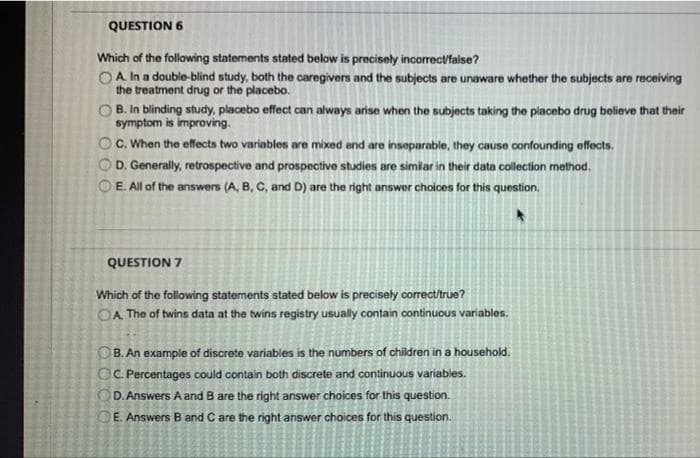QUESTION 6 Which of the following statements stated below is precisely incorrec/false? OA. In a double-blind study, both the caregivers and the subjects are unaware whether the subjects are receiving the treatment drug or the placebo. O B. In blinding study, placebo effect can always arise when the subjects taking the placebo drug believe that their symptom is improving. OC. When the effects two variables are mixed and are inseparable, they cause confounding effects. D. Generally, retrospective and prospective studies are simlar in their data collection method. E. All of the answers (A, B, C, and D) are the right answer choices for this question, QUESTION 7 Which of the following statements stated below is precisely correct/true? OA The of twins data at the twins registry usually contain continuous variables. OB. An example of discrete variables is the numbers of children in a household. OC Percentages could contain both discrete and continuous variables. OD.Answers A and B are the right answer choices for this question. CE. Answers B and C are the right answer choices for this question.
QUESTION 6 Which of the following statements stated below is precisely incorrec/false? OA. In a double-blind study, both the caregivers and the subjects are unaware whether the subjects are receiving the treatment drug or the placebo. O B. In blinding study, placebo effect can always arise when the subjects taking the placebo drug believe that their symptom is improving. OC. When the effects two variables are mixed and are inseparable, they cause confounding effects. D. Generally, retrospective and prospective studies are simlar in their data collection method. E. All of the answers (A, B, C, and D) are the right answer choices for this question, QUESTION 7 Which of the following statements stated below is precisely correct/true? OA The of twins data at the twins registry usually contain continuous variables. OB. An example of discrete variables is the numbers of children in a household. OC Percentages could contain both discrete and continuous variables. OD.Answers A and B are the right answer choices for this question. CE. Answers B and C are the right answer choices for this question.
Linear Algebra: A Modern Introduction
4th Edition
ISBN:9781285463247
Author:David Poole
Publisher:David Poole
Chapter2: Systems Of Linear Equations
Section2.4: Applications
Problem 2EQ: 2. Suppose that in Example 2.27, 400 units of food A, 500 units of B, and 600 units of C are placed...
Related questions
Question

Transcribed Image Text:QUESTION 6
Which of the following statements stated below is precisely incorrec/false?
OA In a double-blind study, both the caregivers and the subjects are unaware whether the subjects are receiving
the treatment drug or the placebo.
B. In blinding study, placebo effect can always arise when the subjects taking the placebo drug believe that their
symptom is improving.
OC. When the effects two variables are mixed and are inseparable, they cause confounding effects.
D. Generally, retrospective and prospective studies are simlar in their data collection method.
E. All of the answers (A, B, C, and D) are the right answer choices for this question.
QUESTION 7
Which of the following statements stated below is precisely correct/true?
OA The of twins data at the twins registry usually contain continuous variables.
OB. An example of discrete variables is the numbers of children in a household.
OC Percentages could contain both discrete and continuous variables.
OD. Answers A and B are the right answer choices for this question.
E. Answers B and C are the right answer choices for this question.
O O O
Expert Solution
This question has been solved!
Explore an expertly crafted, step-by-step solution for a thorough understanding of key concepts.
This is a popular solution!
Trending now
This is a popular solution!
Step by step
Solved in 2 steps

Recommended textbooks for you

Linear Algebra: A Modern Introduction
Algebra
ISBN:
9781285463247
Author:
David Poole
Publisher:
Cengage Learning

Trigonometry (MindTap Course List)
Trigonometry
ISBN:
9781337278461
Author:
Ron Larson
Publisher:
Cengage Learning

Linear Algebra: A Modern Introduction
Algebra
ISBN:
9781285463247
Author:
David Poole
Publisher:
Cengage Learning

Trigonometry (MindTap Course List)
Trigonometry
ISBN:
9781337278461
Author:
Ron Larson
Publisher:
Cengage Learning